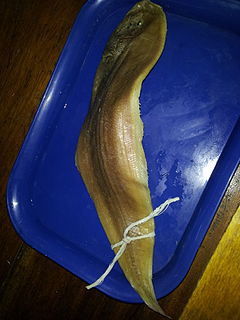
Mackerel is a common name applied to a number of different species of pelagic fish, mostly from the family Scombridae. They are found in both temperate and tropical seas, mostly living along the coast or offshore in the oceanic environment.

Pollock is the common name used for either of the two species of North Atlantic marine fish in the genus Pollachius. Pollachius pollachius is referred to as pollock in both North America and the United Kingdom, while Pollachius virens today is usually known as coley in the British Isles. Other names for P. pollachius include the Atlantic pollock, European pollock, lieu jaune, and lythe; while P. virens is also known as Boston blue, silver bill, or saithe.

Herring are forage fish, mostly belonging to the family Clupeidae.

Sturgeon is the common name for the 27 species of fish belonging to the family Acipenseridae. Their evolution dates back to the Triassic some 245 to 208 million years ago. The family is grouped into four genera: Acipenser, Huso, Scaphirhynchus and Pseudoscaphirhynchus. Four species may now be extinct. Two closely related species, Polyodon spathula and Psephurus gladius are of the same order, Acipenseriformes, but are in the family Polyodontidae and are not considered to be "true" sturgeons. Both sturgeons and paddlefish have been referred to as "primitive fishes" because their morphological characteristics have remained relatively unchanged since the earliest fossil record. Sturgeons are native to subtropical, temperate and sub-Arctic rivers, lakes and coastlines of Eurasia and North America.

Carcharhiniformes, the ground sharks, with over 270 species, are the largest order of sharks. They include a number of common types, such as catsharks, swellsharks, and the sandbar shark.

The Gonostomatidae are a family of mesopelagic marine fish, commonly named bristlemouths, lightfishes, or anglemouths. It is a relatively small family, containing only eight known genera and 32 species. However, bristlemouths make up for their lack of diversity with numbers: Cyclothone, with 12 species, is thought to be the most abundant vertebrate genus in the world, numbering in the hundreds of trillions to quadrillions.

The roosterfish, Nematistius pectoralis, is a game fish found in the warmer waters of the East Pacific from Baja California to Peru. It is the only species in the genus Nematistius and the family Nematistiidae. It is distinguished by its "rooster comb", seven very long spines of the dorsal fin.

Echinorhinus is the only extant genus in the family Echinorhinidae.

Snipe eels are a family, Nemichthyidae, of eels that consists of nine species in three genera. They are pelagic fishes, found in every ocean, mostly at depths of 300–600 m but sometimes as deep as 4000 m. Depending on the species, adults may reach 1–2 m (39–79 in) in length, yet they weigh only 80-400 g. They are distinguished by their very slender jaws that separate toward the tips as the upper jaw curves upward. The jaws appear similar to the beak of the bird called the snipe. Snipe eels are oviparous, and the juveniles, called Leptocephali, do not resemble the adults but have oval, leaf-shaped and transparent bodies. Different species of snipe eel have different shapes, sizes and colors. The similarly named bobtail snipe eel is actually in a different family and represented by two species, the black Cyema atrum and the bright red Neocyema erythrosoma.

Tonguefishes are flatfishes in the family Cynoglossidae. They are distinguished by the presence of a long hook on the snout overhanging the mouth, and the absence of pectoral fins. Their eyes are both on the left side of their bodies, which also lack a pelvic fin. This family has three genera with a total of more than 140 species. The largest reaches a length of 66 cm (26 in), though most species only reach half that size or less. They are found in tropical and subtropical oceans, mainly in shallow waters and estuaries, though a few species found in deep sea floors, and a few in rivers.

Thunnus is a genus of ocean-dwelling, ray-finned bony fish from the Scombridae (mackerel) family. More specifically, Thunnus is one of five genera which make up the Thunnini tribe – a tribe that is collectively known as the tunas. Also called the true tunas or real tunas, Thunnus consists of eight species of tuna, divided into two subgenera. The word Thunnus is the Middle Latin form of the Ancient Greek: θύννος, translit. (thýnnos), lit. 'tunny-fish' – which is in turn derived from θύνω (thynō), "to rush; to dart". The first written use of the word was by Homer.

Gagata is a genus of sisorid catfishes native to Asia.

An anchovy is a small, common forage fish of the family Engraulidae. Most species are found in marine waters, but several will enter brackish water and some in South America are restricted to fresh water.

Fish are very diverse animals and can be categorised in many ways. This article is an overview of some of ways in which fish are categorised. Although most fish species have probably been discovered and described, about 250 new ones are still discovered every year. According to FishBase, 33,100 species of fish had been described by April 2015. That is more than the combined total of all other vertebrate species: mammals, amphibians, reptiles and birds.

Several species of fish are claimed to produce hallucinogenic effects when consumed. For example, Sarpa salpa, a species of sea bream, is commonly claimed to be hallucinogenic. These widely distributed coastal fish are normally found in the Mediterranean and around Spain, and along the west and south coasts of Africa. Occasionally they are found in British waters. They may induce hallucinogenic effects that are purportedly LSD-like if eaten. In 2006, two men who apparently ate the fish experienced hallucinations lasting for several days. The likelihood of hallucinations depends on the season. Sarpa salpa is known as "the fish that makes dreams" in Arabic.

Li Sizhong was an ichthyologist with the Institute of Zoology (中国科学院动物研究所) at the Chinese Academy of Sciences. Throughout his research career, he made numerous discoveries of new fish species, and published many books and research papers describing the fauna and geographical distribution of fishes in China and beyond. He translated and helped publication of the Chinese editions of Fishes of the World and Fish Migration. Li was the major author of two published volumes in the Fauna Sinica monograph series, systematically reviewing and describing orders of bony fishes that include flat fish, cod, silverside, pearlfish, killifish, flying fish, etc. in or near China. He had written over 40 popular science articles about fish on Chinese newspapers and magazines, and been responsible for compiling and editing fish-related entries in several standard reference books.
Clupea is genus of planktivorous bony fish belonging to the family Clupeidae, commonly known as herrings. They are found in the shallow, temperate waters of the North Pacific and the North Atlantic oceans, including the Baltic Sea. Three species of Clupea are recognized. The main taxa, the Atlantic herring and the Pacific herring may each be divided into subspecies. Herrings are forage fish moving in vast schools, coming in spring to the shores of Europe and America, where they form important commercial fisheries.


















